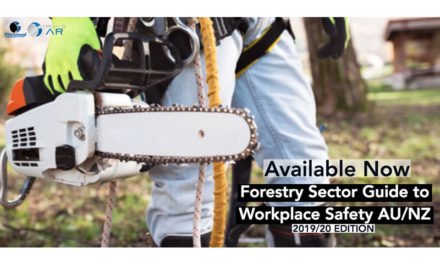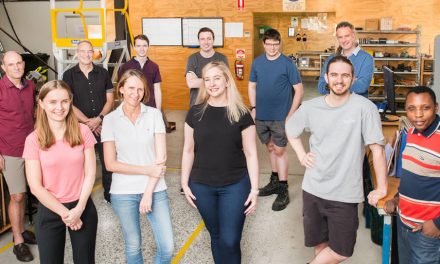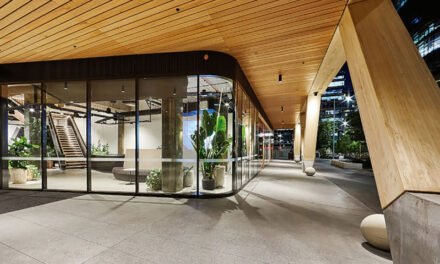The Victorian Government and Hancock Victorian Plantations have finalised a $120m agreement. We talked with HVP CEO Stephen Ryan about what this will, and won’t, mean. By Donyale Harrison
Supply has been perhaps the biggest issue discussed in the timber sector in recent years. The Victorian State Government’s $120 million investment in new plantation estates is a step in addressing the issue long-term.
Hancock Victorian Plantations (HVP), which currently manages about 165,000 ha of mostly pine plantation, won the tender process and has had their initial plan to manage the planting of 16 million new trees accepted. We spoke with HVP’s CEO Stephen Ryan about the plan’s impact.
“We’re excited about it,” Ryan says. “This was a proposal that the State Government has been working on for a couple of years. Part of the Victorian forestry plan is to shut down native forestry logging and expand plantation forestry, particularly in the Gippsland area. There was a public tender process that commenced last year and went for quite some time, and we were the successful party.”
He notes that there is a certain circularity here, saying: “The genesis of HVP was the sell-off some 24 years ago by the state government of the plantation pine resource. We’ve run that resource on a commercial basis very well for the last 24 years and will continue to do that. The issue has been a lack of expansion of the plantation resource, not just in Victoria but, really, across Australia. The projections by 2050 of the demand on wood products are through the roof. And unless we start planting trees, we’re not going to be able to meet that demand.”
ABARES figures looking at plantation growth over the past 25 years show a brief lift during the peak Managed Investment Scheme (MIS) years, then an abrupt decline after the GFC, which saw several major MIS companies go bust. Since then, the softwood plantation area (essential for both building timbers and EWP) has remained fairly stable while hardwood has begun to decline.
“The MIS model was flawed,” Ryan says “and it resulted in a sell-off of some of that land. Since then, there’s been no further developments and then the main reason for that is down to the initial cost of land, which is quite prohibitive. Forestry is a long-term crop: it’s at least 15 years before you start getting your first return and 25 to 30 years before you get your major return. Add in pests, disease and bushfires, and it’s a risky business.
“There needs to be a reasonable return on investment for people to take on that commitment over that length of time. It needed government support, and that’s where the Victorian Government is to be commended on taking this initiative. Because it’s the first real support for plantations that’s taken place in the last 20 years in Australia.”
The funding seeks to expand the existing plantation estate. Ryan says HVP is looking at a mixed model for achieving that, made up of some new land purchases from current private landholders, but also – helping to get the best value from the investment given the high cost of land – going into a range of partnerships with landholders.
“So we may lease the land or there could be private landowners who are interested in entering into farm forestry arrangements with us,” says Ryan.
This ties in with a parallel push from the Department of Agriculture, FWPA and more to lift the rates of farm forestry, in part because it provides an additional (if long-term) source of cash-flow to farmers, but also because of significant productivity and financial benefits thanks to increased shelter for stock, biodiversity improvements and land restoration benefits. At one location noted in FWPA’s 2020 report Lifting farmgate profitability through high value modular agroforestry, tree planting helped increase pasture productivity by 30%.
Ryan emphasises that HVP is open-minded when it comes to the how: “It’s not about land acquisition; it’s about the expansion of the plantation forestry estate,” he says.
“We’ve seen these models work well overseas and there have been successful Australian pioneers who’ve seen the benefits on their farms, too
“I believe the state government has also provided some funding to VicForests to set up models and to explore those opportunities with farmers for farm forestry. And that’s something that we would like to support them in. We’re not educationalists ourselves, but there’s been a lot of good work done by the University of Melbourne, FWPA, Australian Forest Products Association and even over in Western Australia as well as the Gippsland Forestry Hub. It’s just a matter of pulling it all together.”
CATCHING UP
So far, it’s all a good news story, but Ryan, while rightly proud of the work HVP will be doing, cautions that it is “a drop in the ocean”. He says, “This should all have happened 20 or more years ago. The industry has needed and wanted this sort of investment for so long. There’s an adage in forestry that the best time to plant trees was 25 years ago. The second-best time is now – and we’re getting on and doing it. That’s the good news. The bad news is, it’s going to take 25 years before we reap the benefits of it, and the industry is going to struggle over that time to be able to increase wood supply.”
The plantation establishment plan currently stretches over the next eight to 10 years, with plantings scheduled to begin in 2023. “The trees that we plant will take 25-30 years before they’re available for wood product purposes,” says Ryan.
“Meanwhile, the timber industry is doing a great job of showing that wood’s a far better product to use versus steel and concrete in building resources, certainly much better for the environment, but all those products require your basic wood fibre supply. There’s not enough of it now, and the demand will only increase. Unless we increase the number of trees in the ground, we’re not going to be able to meet that demand.”
While imports will always be part of the story, the past few years have shown the problems with relying on imports that may not be available to our market, may not be at a price the local market wants to pay and may not have any way to get here.
“The future is definitely in plantation forestry,” Ryan says. “And it does need this sort of support. All plantation forestry had its start in government – whether established as a public resource or government-funded programs – because of the high risk and the length of time it takes to actually develop before you get a return. All of the companies that operate today started off one way or another in that manner. So anyone thinking plantation forestry is going to expand without some sort of support from the government is really kidding themselves.
“However, it doesn’t need a lot of government support. The main thing the industry needs is access to land and now good support from under the emissions reduction schemes as well. Because with the benefits of growing trees for carbon sequestration and the availability of carbon credits, that’s now actually helping to bridge that economic gap to make it worthwhile to expand plantations.”
Ryan hopes that more state governments will follow in Victoria’s footsteps to offer real financial support when it comes to expanding the plantation resource available to the Australian timber industry. This initiative represents 14,500 ha of additional plantations, while FWPA estimates Australia requires 468,000 ha of additional softwood plantation by 2050 to meet projected demand.
However, the very size of that demand argues in favour of government investment. It will be underpinning a resource needed to meet the large shortfall in the national housing stock as well as to feed the growing number of local engineered wood product manufacturing plants and all the jobs that rely on this manufacture and construction. About 8.7% of the Australian workforce is employed in construction
“And there are jobs at every stage of this process, over the entire life cycle of the trees,” Ryan says. “There’s the work that we engage with contractors to do site preparation, road work, site establishment works… we then maintain the property right through to when it’s ready to harvest. Then we’ll have harvest contractors and haulage contractors and of course, that will all be supplied into the local mills. So we won’t only generate additional jobs, but it will help preserve and protect existing ones.”
The other major benefit of plantation growth to the timber industry is side-stepping the debate around native forestry as resource versus habitat. The undeniable sustainability of timber-based construction is a very strong argument for the industry, but one that historically hasn’t outweighed the cuteness of a koala in the public mind. Victoria’s investment comes off the back of a plan to phase out harvesting in native forests by 2030. In WA, native logging will cease from 2024 (the McGowan Government has announced a record $350 million investment in new softwood plantations across South-West WA).
“All wood products start with either native forestry or plantations,” says Ryan. “I don’t have a view one way or the other on native forestry. But when it comes to convincing the market of our environmental credentials, plantation forestry growers are certified under internationally recognised schemes that have very strong community and environmental standards and requirements that must be adhered to. I think that’s a very clear sign that plantation forestry has been developed in a in a very responsible way.
“We’re plantation forestry growers and that’s what we focus on. But whatever view you have on native forestry and whether it should continue or not, we still need to grow plantation forestry. And that’s what I think is being lost in the debate that parts of the sector are having at the moment. Regardless of what happens with native forestry, plantation forestry still needs to grow to support the building industry and most of the building products we use.”
The proposed new HVP-managed plantations focus on Gippsland, where supporting industries including pulp mills for thinnings already operate and the infrastructure and workforce are both well established. “All the mills and processors there are geared up to process Radiata pine,” says Ryan, “which is our species of choice. So this will all be new greenfield development of Radiata pine.”
The Victorian Government, with an eye on the looming State Election, has announced the new plantation resource will underpin 2000 new and existing jobs in regional Victoria. The numbers are up for debate, but it is a solid investment in future sustainable forestry.
For Ryan, though, it’s an investment in much more than that. “We need to increase the number of trees in the ground,” he says. “It’s the only way we can hope to meet demand. That’s the problem we need to tackle. It’s been talked about for too long; we need action. I’m pleased that this is a start. But as I said before, it really is just a drop in the ocean of what’s needed.”
For more, visit www.hvp.com.au. Download the reports mentioned in this story at www.agriculture.gov.au/abares/research-topics/forests/forest-economics/plantation-and-log-supply and www.fwpa.com.au/resources/reports/market-access/2441-future-market-dynamics-and-potential-impacts-on-australian-timber-imports-interim-report-released.html
Image: A recently planted Radiata pine plantation managed by HVP. The Victorian Government plan will see an additional 14,500 ha established.












